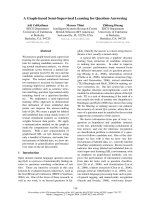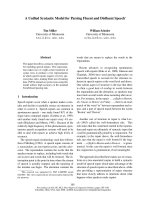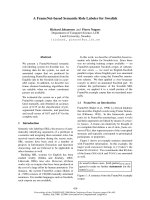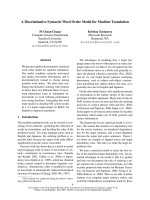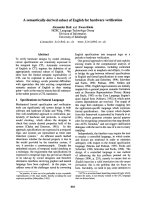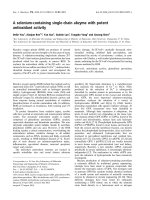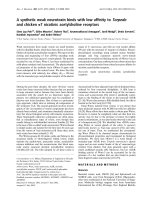Báo cáo khoa học: "A Unified Single Scan Algorithm for Japanese Base Phrase Chunking and Dependency Parsing" pdf
Bạn đang xem bản rút gọn của tài liệu. Xem và tải ngay bản đầy đủ của tài liệu tại đây (201.42 KB, 4 trang )
Proceedings of the ACL-IJCNLP 2009 Conference Short Papers, pages 49–52,
Suntec, Singapore, 4 August 2009.
c
2009 ACL and AFNLP
A Unified Single Scan Algorithm
for Japanese Base Phrase Chunking and Dependency Parsing
Manabu Sassano
Yahoo Japan Corporation
Midtown Tower,
9-7-1 Akasaka, Minato-ku,
Tokyo 107-6211, Japan
Sadao Kurohashi
Graduate School of Informatics,
Kyoto University
Yoshida-honmachi, Sakyo-ku,
Kyoto 606-8501, Japan
Abstract
We describe an algorithm for Japanese
analysis that does both base phrase chunk-
ing and dependency parsing simultane-
ously in linear-time with a single scan of a
sentence. In this paper, we show a pseudo
code of the algorithm and evaluate its per-
formance empirically on the Kyoto Uni-
versity Corpus. Experimental results show
that the proposed algorithm with the voted
perceptron yields reasonably good accu-
racy.
1 Introduction
Single scan algorithms ofparsing are important for
interactive applications of NLP. For instance, such
algorithms would be more suitable for robots ac-
cepting speech inputs or chatbots handling natural
language inputs which should respond quickly in
some situations even when human inputs are not
clearly ended.
Japanese sentence analysis typically consists of
three major steps, namely morphological analysis,
bunsetsu (base phrase) chunking, and dependency
parsing. In this paper, we describe a novel algo-
rithm that combines the last two steps into a sin-
gle scan process. The algorithm, which is an ex-
tension of Sassano’s (2004), allows us to chunk
morphemes into base phrases and decide depen-
dency relations of the phrases in a strict left-to-
right manner. We show a pseudo code of the al-
gorithm and evaluate its performance empirically
with the voted perceptron on the Kyoto University
Corpus (Kurohashi and Nagao, 1998).
2 Japanese Sentence Structure
In Japanese NLP, it is often assumed that the struc-
ture of a sentence is given by dependency relations
Meg-ga kare-ni ano pen-wo age-ta.
Meg-subj to him that pen-acc give-past.
ID 0 1 2 3 4
Head 4 4 3 4 -
Figure 1: Sample sentence (bunsetsu-based)
among bunsetsus. A bunsetsu is a base phrasal
unit and consists of one or more content words fol-
lowed by zero or more function words.
In addition, most of algorithms of Japanese de-
pendency parsing, e.g., (Sekine et al., 2000; Sas-
sano, 2004), assume the three constraints below.
(1) Each bunsetsu has only one head except the
rightmost one. (2) Dependency links between bun-
setsus go from left to right. (3) Dependency links
do not cross one another. In other words, depen-
dencies are projective.
A sample sentence in Japanese is shown in Fig-
ure 1. We can see all the constraints are satisfied.
3 Previous Work
As far as we know, there is no dependency parser
that does simultaneously both bunsetsu chunking
and dependency parsing and, in addition, does
them with a single scan. Most of the modern
dependency parsers for Japanese require bunsetsu
chunking (base phrase chunking) before depen-
dency parsing (Sekine et al., 2000; Kudo and Mat-
sumoto, 2002; Sassano, 2004). Although word-
based parsers are proposed in (Mori et al., 2000;
Mori, 2002), they do not build bunsetsus and are
not compatible with other Japanese dependency
parsers. Multilingual parsers of participants in the
CoNLL 2006 shared task (Buchholz and Marsi,
2006) can handle Japanese sentences. But they are
basically word-based.
49
Meg ga kare ni ano pen wo age-ta.
Meg subj him to that pen acc give-past.
ID 0 1 2 3 4 5 6 7
Head 1 7 3 7 6 6 7 -
Type B D B D D B D -
Figure 2: Sample sentence (morpheme-based).
“Type” represents the type of dependency relation.
4 Algorithm
4.1 Dependency Representation
In our proposed algorithm, we use a morpheme-
based dependency structure instead of a bunsetsu-
based one. The morpheme-based representation
is carefully designed to convey the same informa-
tion on dependency structure of a sentence without
the loss from the bunsetsu-based one. The right-
most morpheme of the bunsetsu t should modify
the rightmost morpheme of the bunsetsu u when
the bunsetsu t modifies the bunsetsu u. Every
morpheme except the rightmost one in a bunsetsu
should modify its following one. The sample sen-
tence in Figure 1 is converted to the sentence with
our proposed morpheme-based representation in
Figure 2.
Take for instance, the head of the 0-th bunsetsu
“Meg-ga” is the 4-th bunsetsu “age-ta.” in Fig-
ure 1. This dependency relation is represented by
that the head of the morpheme “ga” is “age-ta.” in
Figure 2.
The morpheme-based representation above can-
not explicitly state the boundaries of bunsetsus.
Thus we add the type to every dependency rela-
tion. A bunsetsu boundary is represented by the
type associated with every dependency relation.
The type “D” represents that this relation is a de-
pendency of two bunsetsus, while the type “B”
represents a sequence of morphemes inside of a
given bunsetsu. In addition, the type “O”, which
represents that two morphemes do not have a de-
pendency relation, is used in implementations of
our algorithm witha trainable classifier. Following
this encoding scheme of the type of dependency
relations bunsetsu boundaries exist just after the
morphemes that have the type “D”. Inserting “|”
after every morpheme with “D” of the sentence in
Figure 2 results in Meg-ga |kare-ni | ano | pen-wo
| age-ta. This is identical to the sentence with the
bunsetsu-based representation in Figure 1.
Input: w
i
: morphemes in a given sentence.
N: the number of morphemes.
Output: h
j
: the head IDs of morphemes w
j
.
t
j
: the type of dependency relation. A possible
value is either ”B”, ”D”, or ”O”.
Functions: Push(i, s): pushes i on the stack s.
Pop(s): pops a value off the stack s.
Dep(j, i, w, t): returns true when w
j
should
modify w
i
. Otherwise returns false. Sets
always t
j
.
procedure Analyze(w, N, h, t)
var s: a stack for IDs of modifier morphemes
begin
Push(−1, s); { −1 for end-of-sentence }
Push(0, s);
for i ← 1 to N −1 do begin
j ← Pop(s);
while (j = −1
and (Dep(j, i, w, t) or (i = N −1)) ) do
begin
h
j
← i; j ← Pop(s)
end
Push(j, s); Push(i, s)
end
end
Figure 3: Pseudo code for base phrase chunking
and dependency parsing.
4.2 Pseudo Code for the Proposed Algorithm
The algorithm that we propose is based on (Sas-
sano, 2004), which is considered to be a simple
form of shift-reduce parsing. The pseudo code of
our algorithm is presented in Figure 3. Important
variables here are h
j
and t
j
where j is an index
of morphemes. The variable h
j
holds the head ID
and the variable t
j
has the type of dependency re-
lation. For example, the head and the dependency
relation type of “Meg” in Figure 2 are represented
as h
0
= 1 and t
0
= “B” respectively. The flow
of the algorithm, which has the same structure as
Sassano’s (2004), is controlled with a stack that
holds IDs for modifier morphemes. Decision of
the relation between two morphemes is made in
Dep(), which uses a machine learning-based clas-
sifier that supports multiclass prediction.
The presented algorithm runs in a left-to-right
manner and its upper bound of the time complex-
ity is O(n). Due to space limitation, we do not
discuss its complexity here. See (Sassano, 2004)
50
for further details.
5 Experiments and Discussion
5.1 Experimental Set-up
Corpus For evaluation, we used the Kyoto Uni-
versity Corpus Version 2 (Kurohashi and Nagao,
1998). The split for training/test/development is
the same as in other papers, e.g., (Uchimoto et al.,
1999).
Selection of a Classifier and its Setting We im-
plemented a parser with the voted perceptron (VP)
(Freund and Schapire, 1999). We used a poly-
nomial kernel and set its degree to 3 because cu-
bic kernels proved to be effective empirically for
Japanese parsing (Kudo and Matsumoto, 2002).
The number of epoch T of VP was selected using
the development test set. For multiclass predic-
tion, we used the pairwise method (Kreßel, 1999).
Features We have designed rather simple fea-
tures based on the common feature set (Uchimoto
et al., 1999; Kudo and Matsumoto, 2002; Sassano,
2004) for bunsetsu-based parsers. We use the fol-
lowing features for each morpheme:
1. major POS, minor POS, conjugation type,
conjugation form, surface form (lexicalized
form)
2. Content word or function word
3. Punctuation (periods and commas)
4. Open parentheses and close parentheses
5. Location (at the beginning or end of the sen-
tence)
Gap features between two morphemes are also
used since they have proven to be very useful and
contribute to the accuracy (Uchimoto et al., 1999;
Kudo and Matsumoto, 2002). They are repre-
sented as a binary feature and include distance (1,
2, 3, 4 – 10, or 11 ≤), particles, parentheses, and
punctuation.
In our proposed algorithm basically two mor-
phemes are examined to estimatetheir dependency
relation. Context information about the current
morphemes to be estimated would be very use-
ful and we can incorporate such information into
our model. We assume that we have the j-th mor-
pheme and the i-th one in Figure 3. We also use
the j −n, , j −1, j +1, , j + n morphemes and
the i − n, , i − 1, i + 1, , i + n ones, where n
Measure Accuracy (%)
Dependency Acc. 93.96
Dep. Type Acc. 99.49
Both 93.92
Table 1: Performance on the test set. This result is
achieved by the following parameters: The size of
context window is 2 and epoch T is 4.
Bunsetsu-based Morpheme-based
Previous 88.48 95.09
Ours NA 93.96
Table 2: Dependency accuracy. The system with
the previous method employs the algorithm (Sas-
sano, 2004) with the voted perceptron.
is the size of the context window. We examined 0,
1, 2 and 3 for n.
5.2 Results and Discussion
Accuracy Performances of our parser on the test
set is shown in Table 1. The dependency accuracy
is the percentage of the morphemes that have a
correct head. The dependency type accuracy is the
percentage of the morphemes that have a correct
dependency type, i.e., “B” or “D”. The bottom line
of Table 1 shows the percentage of the morphemes
that have both a correct head and a correct depen-
dency type. In all these measures we excluded the
last morpheme in a sentence, which does not have
a head and its associated dependency type.
The accuracy of dependency type in Table 1
is interpreted to be accuracy of base phrase
(bunsetsu) chunking. Very accurate chunking is
achieved.
Next we examine the dependency accuracy. In
order to recognize how accurate it is, we com-
pared the performance of our parser with that of
the parser that uses one of previous methods. We
implemented a parser that employs the algorithm
of (Sassano, 2004) with the commonly used fea-
tures and runs with VP instead of SVM, which
Sassano (2004) originally used. His parser, which
cannot do bunsetsu chunking, accepts only a chun-
ked sentence and then produces a bunsetsu-based
dependency structure. Thus we cannot directly
compare results with ours. To enable us to com-
pare them we gave bunsetsu chunked sentences by
our parser to the parser of (Sassano, 2004) instead
of giving directly the correct chunked sentences
51
Window Size Dep. Acc. Dep. Type Acc.
0 (T = 1) 82.71 99.29
1 (T = 2) 93.57 99.49
2 (T = 4) 93.96 99.49
3 (T = 3) 93.79 99.42
Table 3: Performance change depending on the
context window size
0
0.5
1
1.5
2
2.5
3
0 10 20 30 40 50 60 70 80 90 100
Seconds
Sentence Length (Number of Morphemes)
Figure 4: Running time on the test set. We used
a PC (Intel Xeon 2.33 GHz with 8GB memory on
FreeBSD 6.3).
in the Kyoto University Corpus. And then we re-
ceived results from the parser of (Sassano, 2004),
which are bunsetsu-based dependency structures,
and converted them to morpheme-based structures
that follow the scheme we propose in this paper.
Finally we have got results that have the compat-
ible format and show a comparison with them in
Table 2.
Although the bunsetsu-based parser outper-
formed slightly our morpheme-based parser in this
experiment, it is still notable that our method
yields comparable performance with even a sin-
gle scan of a sentence for dependency parsing in
addition to bunsetsu chunking. According to the
results in Table 2, we suppose that performance of
our parser roughly corresponds to about 86–87%
in terms of bunsetsu-based accuracy.
Context Window Size Performance change de-
pending on the size of context window is shown
in Table 3. Among them the best size is 2. In
this case, we use ten morphemes to determine
whether or not given two morphemes have a de-
pendency relation. That is, to decide the relation
of morphemes j and i (j < i), we use morphemes
j−2, j−1, j, j+1, j+2 and i−2, i−1, i, i+1, i+2.
Running Time and Asymptotic Time Complex-
ity We have observed that the running time is
proportional to the sentence length (Figure 4). The
theoretical time complexity of the proposed algo-
rithm is confirmed with this observation.
6 Conclusion and Future Work
We have described a novel algorithm that com-
bines Japanese base phrase chunking and depen-
dency parsing into a single scan process. The pro-
posed algorithm runs in linear-time with a single
scan of a sentence.
In future work we plan to combine morpholog-
ical analysis or word segmentation into our pro-
posed algorithm. We also expect that structure
analysis of compound nouns can be incorporated
by extending the dependency relation types. Fur-
thermore, we believe it would be interesting to
discuss linguistically and psycholinguistically the
differences between Japanese and other European
languages such as English. We would like to know
what differences lead to easiness of analyzing a
Japanese sentence.
References
S. Buchholz and E. Marsi. 2006. CoNLL-X shared task
on multilingual dependency parsing. In Proc. of CoNLL
2006, pages 149–164.
Y. Freund and R. E. Schapire. 1999. Large margin classifi-
cation using the perceptron algorithm. Machine Learning,
37(3):277–296.
U. Kreßel. 1999. Pairwise classification and support vec-
tor machines. In B. Sch
¨
olkopf, C. J. Burges, and A. J.
Smola, editors, Advances in Kernel Methods: Support
Vector Learning, pages 255–268. MIT Press.
T. Kudo and Y. Matsumoto. 2002. Japanese dependency
analysis using cascaded chunking. In Proc. of CoNLL-
2002, pages 63–69.
S. Kurohashi and M. Nagao. 1998. Building a Japanese
parsed corpus while improving the parsing system. In
Proc. of LREC-1998, pages 719–724.
S. Mori, M. Nishimura, N. Itoh, S. Ogino, and H. Watanabe.
2000. A stochastic parser based on a structural word pre-
diction model. In Proc. of COLING 2000, pages 558–564.
S. Mori. 2002. A stochastic parser based on an SLM with
arboreal context trees. In Proc. of COLING 2002.
M. Sassano. 2004. Linear-time dependency analysis for
Japanese. In Proc. of COLING 2004, pages 8–14.
S. Sekine, K. Uchimoto, and H. Isahara. 2000. Back-
ward beam search algorithm for dependency analysis of
Japanese. In Proc. of COLING-00, pages 754–760.
K. Uchimoto, S. Sekine, and H. Isahara. 1999. Japanese
dependency structure analysis based on maximum entropy
models. In Proc. of EACL-99, pages 196–203.
52
